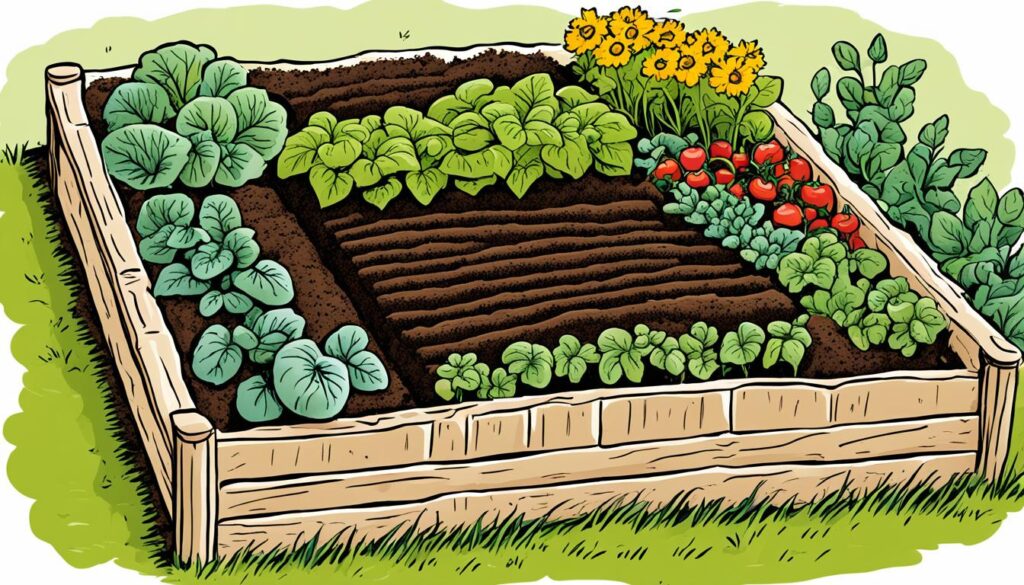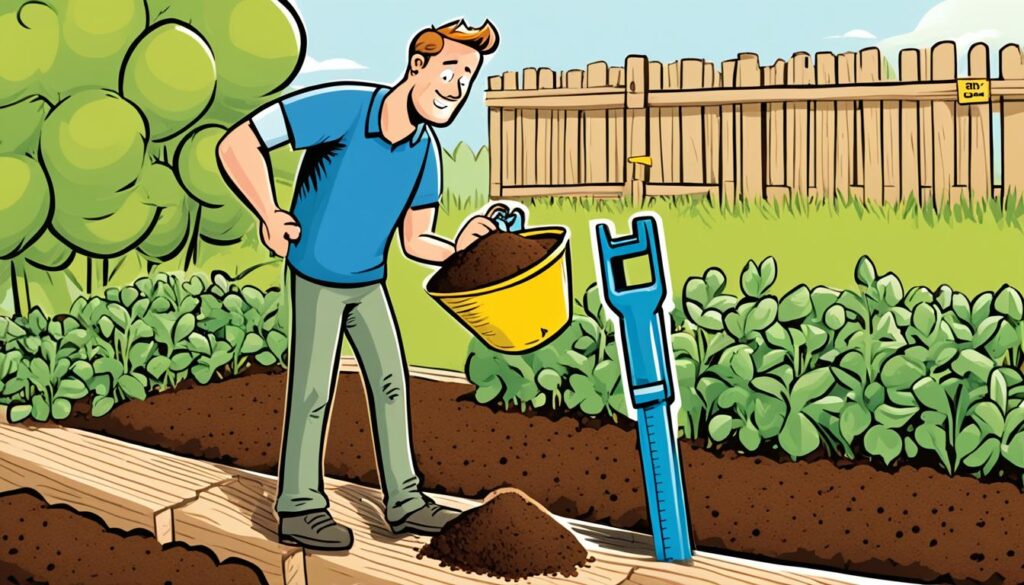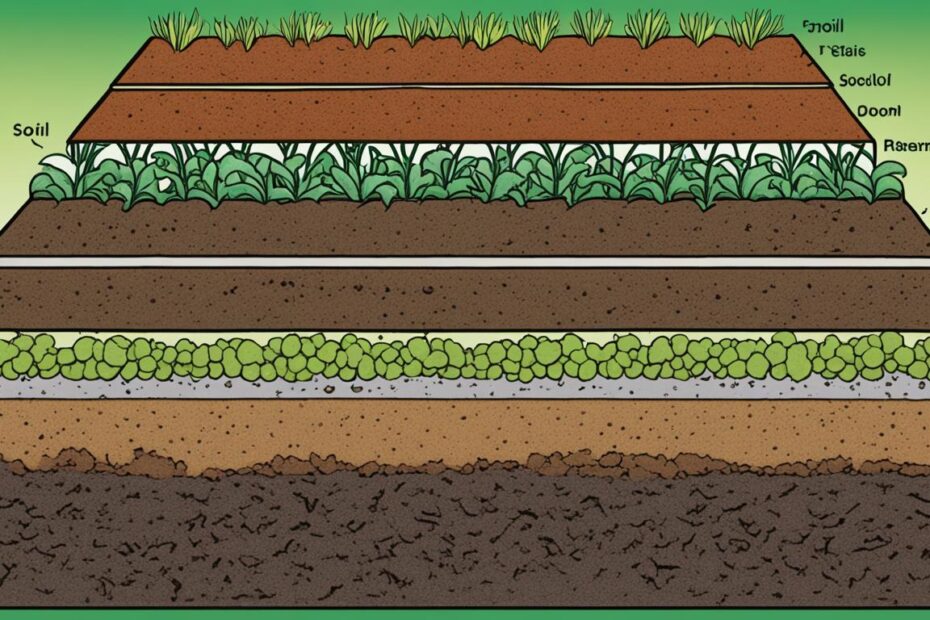Are you planning to create a 4×8 raised bed for your garden? One of the crucial decisions you need to make is how much soil you will need to fill it. Determining the right amount of soil ensures healthy plant growth and a thriving garden. But how many bags of soil do you actually need for a 4×8 raised bed?
In this article, we will guide you through different methods to calculate the soil quantity required for a 4×8 raised bed, making it easy for you to plan and prepare for your gardening project. So let’s dive in and uncover the secrets to obtaining the perfect soil for your raised bed!
- Depth, soil type, and base layer influence the volume of soil needed for a 4×8 raised bed.
- Guidelines and specific soil mixtures can help you estimate the appropriate amount of soil.
- The ideal soil for raised beds is rich in organic matter, well-draining, and nutrient-dense.
- You can choose between buying soil in bags or in bulk, each with its pros and cons.
- There are different methods, such as the soil calculator and area method, to calculate the soil volume needed for your raised bed.
Factors Affecting Soil Volume in a 4×8 Raised Bed
When it comes to filling a 4×8 raised bed with soil, several factors come into play that can affect the volume of soil needed. Understanding these factors is crucial for successful gardening and ensuring optimal plant growth. Consider the following elements:
1. Depth of the Bed
The depth of the raised bed is an essential factor that significantly impacts the soil volume required. The depth of the bed can vary depending on the types of plants you intend to grow. A deeper bed allows for the cultivation of a wider range of plants, while a shallower bed may be suitable for certain herbs or vegetables.
2. Type of Soil
The type of soil you choose to fill your raised bed with can also influence the overall volume. Different soil types have varying densities, which can impact the amount of soil needed. For example, clay soil is denser and heavier, requiring more volume to fill a given area, while sandy soil is lighter and requires less volume.
3. Base Layer
Including a base layer in your raised bed, such as gravel or landscape fabric, can affect the soil volume required. The base layer provides additional support, improves drainage, and helps prevent weed growth. When calculating soil needs, it’s important to account for the volume of the base layer as well.
To ensure accurate soil volume estimation for your 4×8 raised bed, consider these factors and make necessary adjustments in your calculations. By taking into account the bed depth, type of soil, and the inclusion of a base layer, you can determine the ideal amount of soil needed for your raised bed, providing the optimal growing environment for your plants.
Continue reading to learn how to calculate the precise amount of soil you need for your 4×8 raised bed and discover the best soil mixture for successful gardening.
How Much Soil Do You Need for a 4×8 Raised Bed?
When planning your 4×8 raised bed, determining the necessary soil quantity is essential for successful gardening. The amount of soil required depends on the bed’s depth and the type of soil mixture you choose.
If you opt for a 12-inch deep bed, a suitable soil mixture consists of equal parts topsoil and compost. In this case, you will need approximately 24 cubic feet of soil. However, if you decide to use only topsoil, the quantity increases to about 30 cubic feet, while using only compost requires around 18 cubic feet of soil. These estimates serve as general guidelines and can be adjusted based on your specific material choices and desired depth.
For an 18-inch deep raised bed, the estimated soil quantity will vary accordingly. Remember, these calculations provide a starting point, and you can customize them to meet your gardening needs.
Creating a thriving garden starts with ensuring the right soil quantity for your 4×8 raised bed. By following these guidelines and considering different depth options and soil mixtures, you can efficiently calculate the required soil volume and pave the way for a bountiful harvest.
CHECK OUR RECOMMENDED PRODUCTSWhat Type of Soil is Best for Raised Beds?
The key to successful gardening in raised bed is having the best soil mix. To provide your plants with an optimal environment for growth, it’s important to choose a soil that is rich in organic matter, well-draining, and nutrient-dense. This will ensure that your plants receive the necessary nutrients, have proper root aeration, and retain moisture effectively.
A recommended soil mixture for raised beds is a combination of one-third compost, one-third topsoil, and one-third potting soil. This composition creates a balanced blend that incorporates organic matter, provides adequate drainage, and offers a nutrient-rich foundation for your plants to thrive.
If you prefer a pre-made soil mix, look for an all-natural, organic potting soil that excludes synthetic fertilizers and pesticides. These mixes are formulated to promote healthy plant growth while maintaining a sustainable and eco-friendly approach to gardening.
Benefits of Organic Matter and Well-Draining Soil
Organic matter, such as compost, plays a vital role in sustaining soil health and fertility. It enriches the soil with essential nutrients and microorganisms, promotes root development, and improves moisture retention. By incorporating organic matter into your raised bed soil mix, you are creating a nutrient-dense environment that supports strong and vibrant plant growth.
Well-draining soil is essential for preventing waterlogged conditions that can drown plant roots and lead to root rot. Adequate drainage allows excess water to escape, ensuring that the soil moisture level remains balanced and provides oxygen to the roots. This prevents the accumulation of water and creates a favorable environment for healthy root development.
“Choosing the right soil mix for your raised beds is the foundation of successful gardening. By providing your plants with the ideal growing medium, you are setting them up for success from the very beginning.”
Enhancing Drainage and Aeration with Perlite and Vermiculite
In addition to compost, topsoil, and potting soil, incorporating perlite and vermiculite into your soil mix can further enhance drainage and aeration. Perlite is a lightweight volcanic rock that helps to loosen the soil, allowing for better airflow and root development. Vermiculite, on the other hand, aids in water retention while maintaining good drainage. These additives balance the soil’s moisture-holding capacity, ensuring optimal plant hydration without the risk of excessive waterlogging.
Here is a table summarizing the benefits of each component in the recommended soil mix for raised beds:
| Soil Component | Benefits |
|---|---|
| Compost | – Rich in nutrients\n- Enhances soil fertility\n- Improves moisture retention\n- Promotes beneficial microorganisms |
| Topsoil | – Provides essential minerals\n- Supports root development\n- Adds bulk to the soil mix |
| Potting Soil | – Ensures proper aeration\n- Balances moisture retention and drainage\n- Enhances nutrient availability |
| Perlite | – Improves soil aeration\n- Enhances drainage\n- Prevents compaction |
| Vermiculite | – Retains moisture\n- Improves water distribution\n- Maintains good drainage |
By understanding the benefits of each soil component and their role in creating an optimal growing environment, you can make informed decisions about the best soil mix for your raised beds.

How to Fill a Raised Bed with Soil?
When it comes to filling a raised bed with soil, you have two options: buying it in bags or purchasing it in bulk. Each option has its own pros and cons, so it’s essential to consider your specific needs before making a decision.
Buying Soil in Bags
Buying soil in bags is a convenient option, especially for small-scale gardening projects. Here are some pros and cons to consider:
Pros:
- Convenience: Bagged soil is readily available at most gardening centers and nurseries.
- Portability: Bags are easy to transport, making them suitable for gardens with limited access.
- Variety: Bagged soil is usually available in different soil mixes to suit specific plant requirements.
Cons:
- Expensive: Buying soil in bags can be more costly compared to purchasing it in bulk.
- Time-consuming: If you have a large raised bed, it may take a significant amount of time to fill it with multiple bags.
- Environmental impact: Some bagged soil mixes may contain peat, which can have negative environmental consequences.
Buying Soil in Bulk
Alternatively, you can opt to purchase soil in bulk, which comes with its own set of advantages and disadvantages:
Pros:
- Cost-effective: Buying soil in bulk is generally more budget-friendly, especially for larger raised beds.
- Customizable: You can choose the type and composition of the soil to best meet your garden’s needs.
- Less packaging waste: Purchasing soil in bulk reduces the amount of plastic waste generated.
Cons:
- Requires transportation: Bulk soil will need to be delivered, requiring access for a truck or a trailer.
- Storage considerations: You will need adequate space to store the extra soil until you’re ready to use it.
- May not be available everywhere: Depending on your location, finding a supplier that offers bulk soil may be challenging.
Choosing the Right Soil Mix
Before buying soil, do some research to determine the suitable types and compositions for your raised bed. Different plants have different soil requirements, so it’s important to choose a soil mix that meets their needs. Here are a few factors to consider:
- The type of plants you will be growing
- The drainage needs of your raised bed
- The nutrient requirements of your plants
By understanding your garden’s needs, you can select the ideal soil mixture that promotes healthy plant growth.
Calculating the Quantity Needed
Calculating the quantity of soil needed can be done using a soil calculator or the area method:
- Soil Calculator: A soil calculator takes into account the dimensions of your raised bed and the desired soil depth. It provides a precise estimate of the quantity of soil required.
- Area Method: The area method involves multiplying the length and width of your raised bed and dividing the result by 27 (the number of cubic feet in a cubic yard). This calculation gives you the approximate number of cubic yards of soil needed.
Consider All Factors
When deciding how to fill your raised bed with soil, consider factors such as cost, availability, convenience, and the environmental impact of different soil mixes. Finding the right balance between these factors will help you make an informed decision that suits your gardening needs.

Soil Calculation Methods for Raised Beds
When it comes to calculating the soil volume needed for your raised bed, there are a few methods you can use: the soil calculator and the area method. Each method has its own advantages and can help you determine the right amount of soil for your raised beds.
The Soil Calculator
The soil calculator is a simple and efficient tool that allows you to input the dimensions of your raised bed and the desired soil depth. With this information, the calculator will determine the quantity of soil you need. It’s a convenient way to get an accurate estimate without any complex calculations.
The Area Method
The area method is another approach to calculate the soil volume for your raised beds. It involves multiplying the length and width of the bed and then dividing the result by 27, which is the cubic feet in a cubic yard. This will give you the number of cubic yards of soil needed for your raised bed.
Example: If your raised bed is 4 feet wide and 8 feet long, the calculation would be (4 ft x 8 ft) ÷ 27 = 1.48 cubic yards of soil. Note: Round up the final result to ensure you have enough soil.
Both the soil calculator and the area method can help you determine the soil quantity needed for your raised beds. Choose the method that suits your preferences and the tools available to you.
| Method | Description |
|---|---|
| Soil Calculator | A tool that requires the input of bed dimensions and desired soil depth to determine the required soil quantity. |
| Area Method | The calculation involves multiplying the length and width of the bed and dividing the result by 27 to determine the number of cubic yards of soil needed. |
Using these methods, you can accurately calculate the soil volume required for your raised beds. Whether you prefer the simplicity of the soil calculator or the manual calculations of the area method, both options will help you plan and prepare for your gardening projects.
By accurately calculating your soil needs, you can ensure your raised beds have the right amount of soil for optimal plant growth and healthy gardening.
Conclusion
Successful raised bed gardening begins with calculating the right amount of soil to fill your 4×8 bed. By taking into account factors such as bed depth, soil type, and the inclusion of a base layer, you can accurately determine the volume of soil needed. Utilizing guidelines and techniques like soil calculators or the area method simplifies the calculation process and ensures you have enough soil on hand.
When filling your raised bed, it’s important to select a suitable soil mixture that is rich in organic matter and provides proper drainage. A well-balanced combination of compost, topsoil, and potting soil is recommended. This will create an optimal environment for your plants to thrive, retaining moisture and supplying essential nutrients.
By carefully calculating and filling your raised bed with soil, you lay the foundation for successful gardening. With the right soil volume and proper soil mixture, you can create an ideal growing environment for your plants and enjoy the benefits of raised bed gardening all season long.
FAQ
How do I calculate the amount of soil needed for a 4×8 raised bed?
To calculate the soil quantity needed for a 4×8 raised bed, consider factors such as bed depth, soil type, and the inclusion of a base layer. You can use a soil calculator or the area method to determine the approximate volume of soil required.
What factors affect the volume of soil needed in a 4×8 raised bed?
The volume of soil required for a 4×8 raised bed is influenced by the depth of the bed, the type of soil used, and whether or not a base layer is included. These factors impact the overall soil volume needed for healthy plant growth.
How much soil do I need for a 4×8 raised bed?
The soil quantity needed for a 4×8 raised bed depends on factors like the depth of the bed and the type of soil mix used. As a general guideline, for a 12-inch deep bed, using a soil mixture of equal parts topsoil and compost, you will need approximately 24 cubic feet of soil.
What type of soil is best for raised beds?
The ideal soil mix for raised beds should be rich in organic matter, well-draining, and nutrient-dense. A recommended mixture includes one-third compost, one-third topsoil, and one-third potting soil. Alternatively, you can choose an all-natural, organic potting soil that excludes synthetic fertilizers and pesticides.
Should I buy soil in bags or in bulk for my raised bed?
The choice between buying soil in bags or in bulk for a raised bed depends on convenience, cost, and transportation. Buying in bags is convenient but can be expensive and time-consuming, while bulk soil is cost-effective but requires transportation. Consider your preferences and resources before making a decision.
What are the methods to calculate soil volume for raised beds?
There are two common methods to calculate soil volume for raised beds. The soil calculator is a simple tool that requires inputting the bed dimensions and desired soil depth to determine the required soil quantity. The area method involves multiplying the length and width of the bed and dividing the result by 27 (the cubic feet in a cubic yard).
How important is it to accurately calculate the soil volume for a raised bed?
Accurately calculating the right amount of soil for your 4×8 raised bed is crucial for successful gardening. By considering factors like bed depth, soil type, and including a base layer, you can determine the approximate volume of soil required. This ensures that you have enough soil for healthy plant growth.
